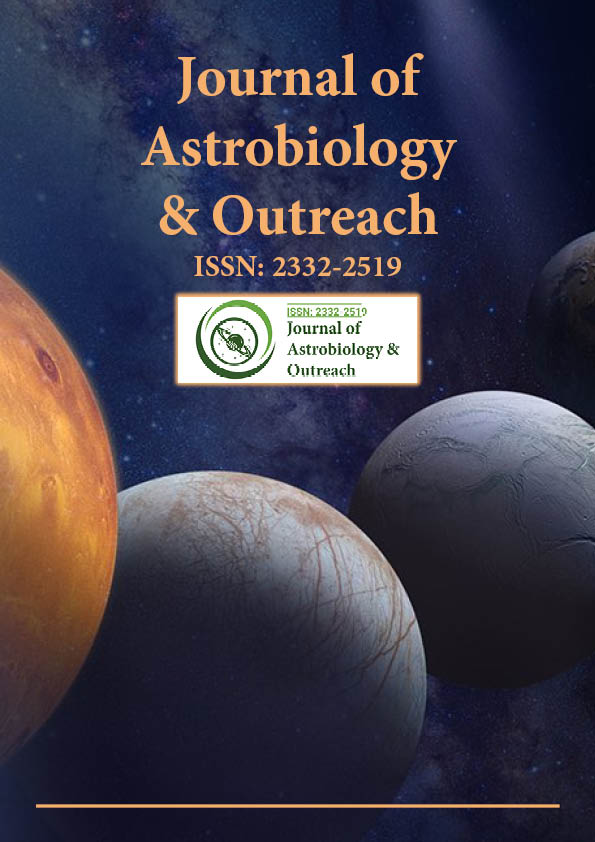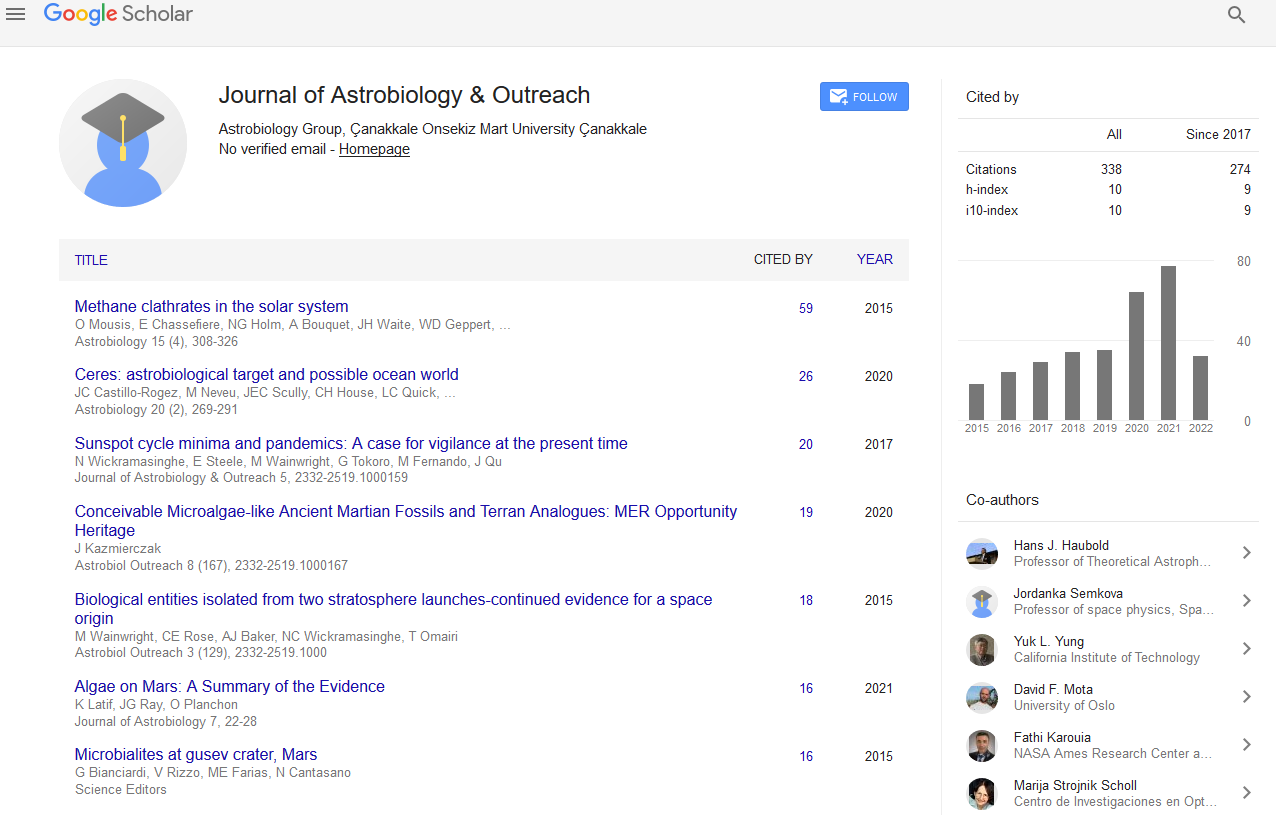Indexed In
- Open J Gate
- Academic Keys
- JournalTOCs
- RefSeek
- Hamdard University
- EBSCO A-Z
- OCLC- WorldCat
- Google Scholar
Useful Links
Share This Page
Journal Flyer

Open Access Journals
- Agri and Aquaculture
- Biochemistry
- Bioinformatics & Systems Biology
- Business & Management
- Chemistry
- Clinical Sciences
- Engineering
- Food & Nutrition
- General Science
- Genetics & Molecular Biology
- Immunology & Microbiology
- Medical Sciences
- Neuroscience & Psychology
- Nursing & Health Care
- Pharmaceutical Sciences
Perspective - (2024) Volume 12, Issue 2
Transforming Nuclear Astrophysics with Advanced Platforms and Collaboration
Alex Brune*Received: 28-May-2024, Manuscript No. JAO-24-27367; Editor assigned: 31-May-2024, Pre QC No. JAO-24-27367 (PQ); Reviewed: 14-Jun-2024, QC No. JAO-24-27367; Revised: 21-Jun-2024, Manuscript No. JAO-24-27367 (R); Published: 28-Jun-2024, DOI: 10.35248/2332-2519.24.12.346
Description
A new platform for nuclear astrophysics studies is emerging, offering innovative methods and tools to enhance in this absorbing field. Nuclear astrophysics, the study of how nuclear reactions contribute to the processes occurring in stars and the synthesis of elements, plays a vital role in our understanding of the universe. The need for more advanced and integrated approaches has prompted the development of this platform, which combines theoretical models, experimental data and observational evidence to provide a comprehensive understanding of cosmic phenomena. The genesis of this platform arises from the recognition that traditional methods often operate in silos, leading to a fragmented understanding of the complex interactions governing stellar evolution and nucleosynthesis. One of the platform's significant features is its ability to incorporate real-time data from various observatories around the world. By analyzing light curves, spectra and other observational data, scientists can test their theoretical models against actual phenomena. For example, when a supernova occurs, the emissions from the explosion provide valuable insights into the nuclear processes at play. By correlating these observations with the data generated by the platform, can refine their models of nucleosynthesis and better understand the conditions leading to the creation of heavy elements.
Another critical aspect of the new platform is its emphasis on collaboration among various scientific disciplines. Nuclear astrophysics inherently intersects with several fields, including nuclear physics, astronomy and cosmology. By promoting interdisciplinary teamwork, the platform encourages scientists from different backgrounds to share insights and methodologies, leading to more studies. This collaborative spirit helps to cultivate a richer understanding of the forces and reactions that drive the cosmos. The platform also advanced computational techniques, including simulations and machine learning algorithms. These tools enable to process vast amounts of data more efficiently and identify patterns that may not be immediately apparent through traditional analysis. For instance, machine learning can assist in predicting the outcomes of specific nuclear reactions under different astrophysical conditions. This predictive capability can streamline experimental design and optimize resource allocation in laboratories dedicated to nuclear exploration. Moreover, the platform prioritizes accessibility to both academics and the public. By making data and findings available in user-friendly formats, it encourages broader engagement with nuclear astrophysics. This transparency fosters an environment where amateur astronomers, educators and enthusiasts can participate in scientific discourse. Increased public interest can lead to greater funding and support for initiatives, ultimately benefiting the entire scientific community.
Additionally, the platform aims to enhance educational opportunities within the field of nuclear astrophysics. By providing resources, workshops and online courses, it seeks to train the next generation of scientists. Understanding the complexities of nuclear reactions and their role in cosmic evolution is essential for aspiring astrophysicists. By integrating educational components, the platform contributes to building a knowledgeable workforce that can tackle the challenges facing modern astronomy. The impact of this new initiative is already being felt within the scientific community. As more utilize the platform, the pace of discovery in nuclear astrophysics is accelerating. By facilitating collaborations, streamlining data analysis and enhancing educational outreach, the platform empowers scientists to explore uncharted territories in astrophysics. For instance, recent studies on the nucleosynthesis of specific isotopes have provided new insights into the processes that occurred during the early universe, shedding light on the formation of stars and galaxies.
The potential for international collaboration also enhances the platform's effectiveness. By connecting worldwide, it promotes the exchange of ideas and expertise. Such collaboration is particularly important in nuclear astrophysics, where experiments often require specialized facilities and equipment that may only be available in certain regions. By pooling resources and knowledge, the global scientific community can tackle problems that might be insurmountable for individual institutions. The emergence of a new platform for nuclear astrophysics studies represents a significant advancement in our understanding of the cosmos. By integrating observational data, theoretical models and interdisciplinary collaboration, this initiative enhances our ability to explore the fundamental processes that shape the universe. With its focus on accessibility, education and international collaboration, the platform is poised to make lasting contributions to the field of nuclear astrophysics, paving the way for future discoveries and insights.
Citation: Brune A (2024). Transforming Nuclear Astrophysics with Advanced Platforms and Collaboration. J Astrobiol Outreach. 12:346.
Copyright: © 2024 Brune A. This is an open-access article distributed under the terms of the Creative Commons Attribution License, which permits unrestricted use, distribution, and reproduction in any medium, provided the original author and source are credited.

